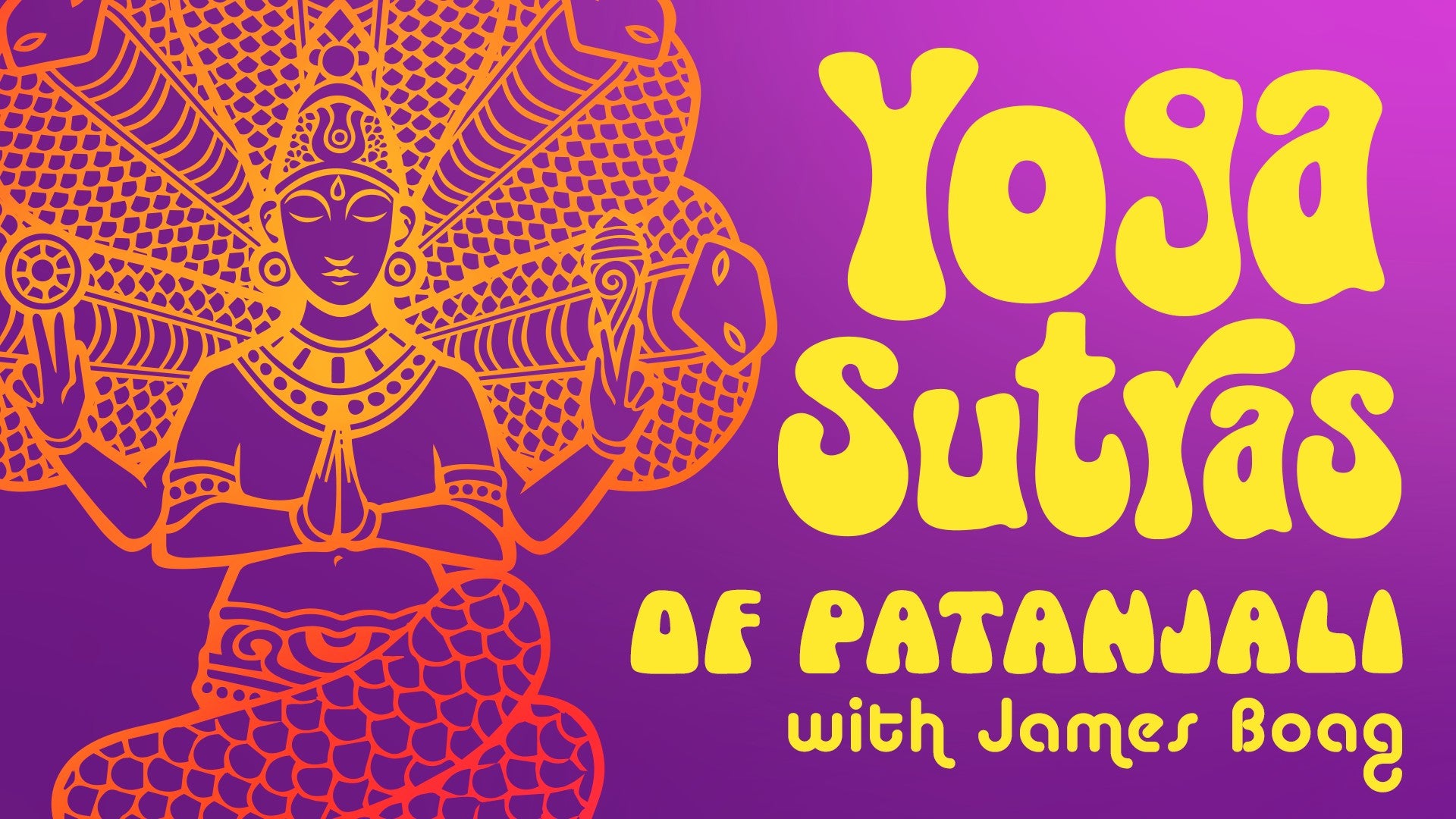Description
James unpacks Sutras 2.2 - 2.5: samadhi bhavana arthah klesha tanu karanarthah cha (2.2) , avidya asmita raga dvesha abhinivesha pancha klesha (2.3), avidya kshetram uttaresham prasupta tanu vicchinna udaranam (2.4), and antiya ashuchi duhkha anatmasu nitya shuchi sukha atman khyatih avidya (2.5). We are introduced to the kleshas, the underlying afflictions that the human existence is heir to, focusing on avidya, or ignorance, which is considered the enabler of all kleshas.
Please see the attached .PDF to follow along with James.
About This Video
Transcript
Read Full Transcript
So in the first sutra, Patanj is laid out this 3 into 1 method for yoga sadhana, for the path of active yoga practice. And next, he's going to tell us what that is for. What is its purpose? What is its aim? So if we're doing this tapas, if we're working with this steady illuminating fire of yogic discipline, if we are practicing svaadhyaya with the spirit of ongoing inquiry, curiosity and wonder, and if we're doing ishwana pranidhana, consecrating our actions, that which we consider the highest, what is it for?
What is the purpose of that? And so Patanj tells us, he says, samadhi bhavanartha klesh dhanu karanaartha shche, shche, and. There are two things it's for. One, to bring up, to encourage, to bolster samadhi on the one hand, and then the other thing that Kriya Yoga is for is to reduce, to attenuate, to get rid of the kleshas. Okay, what a kleshas.
Don't worry, he's going to tell us right next. But basically, what are we practicing for? We're practicing, one, to invite samadhi, to invite that balance, that harmonization, that integration of the whole sphere and field of our awareness, and we want to remove the kleshas. Now, this word, klesha, Patanj now tells in the third sutra what they are. Avidya, asmita, raga, dvisha, bhinni, visha, klesha, so he's mentioned five of them.
Avidya, asmita, raga, dvisha, bhinni, visha, and next, he's going to define them. He's going to tell us what they are and how they operate, but before we get into that, this word klesha, maybe you remember at the beginning of chapter one, when Patanj just described yoga, he said yoga is a state in which there is the chitta vritti nirodha. There is the nirodha, the checking of all of the vrittis, the movements of the chitta, the awareness. And then Patanj went on to say, what's happening when we're not in a state of yoga? And he said that the vrittis, vritti av panjata ya klishta klishta, the ways that the awareness moves are fivefold and they can be klishta or aklishta, so klishta and aklishta.
This is the same root, the same word as klishta. So klishta means it is aklishta and aklishta means it is not aklishta, if that's clear. Basically aklishta is something that blocks our awareness, something that gets in the way of yoga. So let's hear what these things are. Now you might think, wait a minute, didn't you talk about antaraya, things that got in the way of yoga in chapter one?
Yes, the antaraya are the obstacles, the things that can interfere with the clarity of our awareness. The klishas, as we will see now, these are kind of, let's say, more underlying foundational challenges that we have to navigate on the path of yoga. And these klishas are par for the course when we're a human being. These klishas are the afflictions that flesh is heir to. There's no avoiding them, but how to work with them skillfully, that's what yoga is all about.
And that's what Bhutan is going to tell us how to do as he continues. But third sutra has told us these five klishas, avidya asmita raga dvesha, abhinni vesha, and now he's going to start telling us what they are. Now first is avidya, let's say that word together, avidya. Now avidya is a very important word in the yogic system. Maybe you know the word veda, veda means that which is seen, which is recognized, which is revealed, and vid, vid, same root, same verbal root.
Vidya means knowledge, true knowledge, true understanding, true insight. Avidya means other than that. So sometimes it's translated as ignorance, not knowing, something less than knowing accurately. And avidya is described in the fourth sutra. Avidya kshitram utterisham bhrasupta tanu vichannodara nam.
Avidya kshitram, avidya is the field, utterisham, of the others, although what's the other klishas? So avidya, it's the first of the klishas, and it's the foundation, it's the enabler of all the others. So this tells us right away, if we can get rid of avidya, we can get rid of all the other klishas. This is one of the main concerns of chapter two, is how we can work with this experience of avidya. What does avidya do?
How do we diminish it, attenuate it, overcome it? But here in the fourth sutra, we get the first part of the description of avidya, and Patanjhi tells us it is the field, the ground, for all of the other afflictions, for all of the other klishas, whether they are prasuptha, which means whether they are as if asleep, whether they are dormant, whether they are hiding, whether they are not so obvious, tanu, whether they are weak or attenuated or tenuous, we've already worn them down, we've already managed to overcome them to some significant degree, but they're still there, they're still hanging on, vichinna, whether they are coming and going, sometimes they're operating, sometimes they're not, but it all depends on avidya or udharana or whether they are fully operative. So whenever these klishas are at play in whatever form, fully operative, coming and going, alternating between themselves, whether they're operating just one or they're operating as a team and they're interchanging which one of them is playing the dominant role, the dominant blocking role, however they're operating, it's only possible because avidya is in place, because there is some mistaken understanding, there is some partiality of awareness. So avidya, this not seeing accurately, this ignorance, this not having a real grasp of the full picture, this is the field in which all the other klishas, all these other afflictions can grow, can bloom, can blossom and can even propagate. So avidya, the underlying cause of the klishas.
And then in the fifth sutra, we now get Patanjali's really quite famous definition of avidya. And this is a definition which sometimes people who are exploring other shastras in the Indian tradition, other systems of knowledge, they quite often cite Patanjali's definition of avidya because it is so beautifully succinct and to the point. And what does he say? So we have in this sutra, this juxtaposition of apparent pairs of opposites, we've got anitya and then nitya, asuchi and asuchi, dukha and sukha, anatma and atma. So avidya is taking the anitya, that which is not eternal, which is not permanent, which is not everlasting, taking that for that which actually is the eternal.
Avidya is taking the impure for the pure. Avidya is taking dukha, that which actually causes pain and separation and disharmony for sukha, for easefulness and pleasure and agreeableness. Avidya is taking the anatma for taking that which is not our true self, which is not our true essence, to be our true essence. This is avidya. So avidya is basically seeing reality through a distorted, confused, limited lens.
For example, and this is a classic thing in Indian tradition, in the Mahabharata, one of the great epics, there is an episode in which one of the leading characters, Yudhishthira, he has been quizzed by an ethereal voice, it actually happens to be his father who he's never met, who is the god of dharma, the god of law and appropriate action and nature and things like this, and his father quizzes him and one of the questions, the riddles that he sets to his son, one of them is, what is the strangest thing in the world? And Yudhishthira's answer, his wise answer, which meets with his father's approval, is the strangest thing in the world, death is the only certainty for every human being, but almost all of us act like it's never going to come for us. And so this mistaking the non-eternal for the eternal, we think that we will last forever, we think that we will live forever and so we can be very careless about our lives. This is avidya. Ashuchi and shuchi, so the impure for the pure, we think that the things that give us sensory pleasure are pure, but really these are things that are variegated, they're mixed, they come and go, everything that's in the realm of material manifest existence is subject to decay, so it's not really pure, but we think it is.
And then we have dhukha and sukha, and here there's a really lovely thing in the Sanskrit, Sanskrit is often a quite onomatopoeic language, but just to hear the difference, we have dhukha and sukha. So sukham and dhukham, there's this almost sezure, it's from the visarga in the Sanskrit, there's this like dhukha, you can feel it's like it's writhing us apart, there's this separation, there's this disconnection that can be heard in the word dhukha. So we misunderstand things that are actually causes of suffering for that which when we think it's going to be our pleasure. So a classic example, somebody, a human being might think for example, that is my pleasure and what is that? That could be for example some, something which if we have too much of, instead of being a medicine or an nourishment becomes a poison, so there could be a certain type of food that we enjoy, but if we go into it too much it actually isn't having a good effect on us at all.
Or we think for example that some lovely worldly experience is our true pleasure, but there's the idea that even the most pleasurable, beautiful situations and scenarios, they carry the germ of suffering. Because if we're experiencing something that we really love, it's really wonderful, what we're going to feel when it goes away, we like to feel some sense of loss and grief and suffering. So we get confused about where happiness really resides and this is avidya and we get confused about who we really are, what our soul or our essence is. And this can sometimes have a consequence that the way we orient to life doesn't really honor that deepest, subtlest, everlasting part of ourself, but really gets clouded up with our transient sense of identity and that's what Patanju talks about next with asmita. So before we go to that, avidya, ignorance, not seeing clearly, what is it?
It's seeing the things that do not last, mistaking them for the things that are everlasting and eternal. It's seeing the impure for the pure, it's seeing the things that actually cause suffering for things that bring pleasure and seeing that which is not really ourself for ourself. So this misapprehension, this mistaken notion, mistaken understanding of reality, this is avidya, ignorance, partiality, not seeing the full picture. This is the source of our afflictions according to the yogic understanding of reality and this is very important. Yoga also recognizes that when we're a human being with but two eyes, there will always be more that we cannot see than we can and when we have two eyes, we will see duality and we will have preferences.
This is normal. Patanju is going to say more about that in just a moment but one of the consequences of that is that it's very easy for us to become very accustomed to and attached to very partial ignorant views and so as we mentioned with the first sutra, one of the main practices in yoga, let me practice looking in ways that reach beyond my habitual ways of looking. Now I can take my arms out, you can try this, like here I can see my fingers, here I can see my fingers, here I can see my fingers, there comes a point when I can't see them but I can train my peripheral vision to expand and the idea in yoga is let me keep training myself to keep looking in ways that keep expanding my habitual ways of looking and this is its own reward, it is challenging work, it can be very intimidating, it can be quite lonely at times to break through into a new level of insight where the people around us might not be used to looking with that depth or level of analysis but when we keep making that honest effort, we will learn more about ourselves and we will be able to then access more of that samadhi which is its own reward and is its own self-repelling practice. The way of sadhana, the straight path, the exacting path, sometimes the path of yoga is likened to walking a precipice or walking a tightrope or the razor's edge but imagine you start walking a precipice, you start getting accustomed to dancing along the tightrope of life, to walking the razor's edge, when you walk a razor's edge how do you feel? It brings us fully into the present moment.
If you have ever tried tightrope walking or slack lining, you know when you are bouncing on the tightrope or the slack line, maybe if you are a super advanced slack liner or tightrope walk you can do it quite easily but when I tried it, and even if you are very very advanced, if you are doing it over a high gorge or a big drop, it brings you very much into the present moment and as we come into the present moment, the moment becomes fuller, richer. We start to access that space in which the action is its own fulfilment, its own reward and once we get accustomed to that, how does it feel to walk on the flat sidewalk that is several metres wide? It doesn't quite cut it anymore. The system wants that heightened subtler more integrated presence of the tightrope but that requires that constant steady effort, that 360 effort, that holistic effort to actually keep inviting ourselves more and more into the field of our own recognition because if we are going to come out of this partiality, this blinkeredness, these limits of our avidya, that is the only way we can do it. We have to keep inviting ourselves to look in ways that reach beyond our habitual ways of looking and think in ways that go beyond what we might even previously even dreamed of.
Yoga Sutras of Patanjali: The Purpose of Yoga
Comments


You need to be a subscriber to post a comment.
Please Log In or Create an Account to start your free trial.








